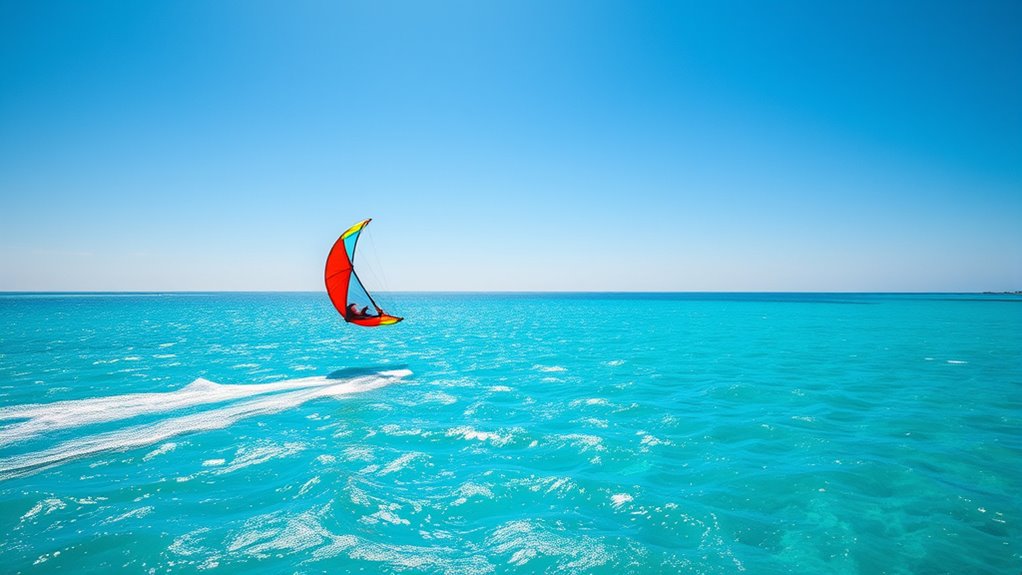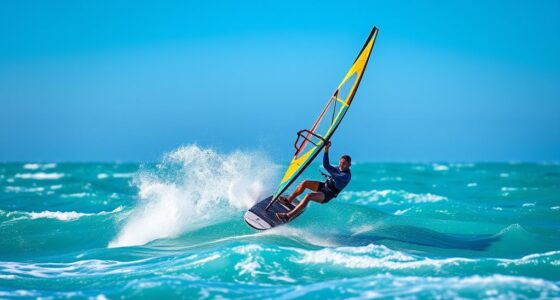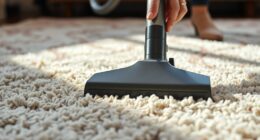The wind window for kitefoilers is the cone-shaped area where your kite interacts with the wind to generate lift and control. It extends from your board and varies based on wind strength, obstacles, and terrain. Staying within the ideal zones ensures powerful, steady pulls and smooth handling, while venturing outside can cause turbulence and instability. Mastering how to position your kite within this window helps you harness better performance—for more details, keep exploring this essential concept.
Key Takeaways
- The wind window is a cone-shaped area around the rider, defining where the kite can generate optimal lift and control.
- Its angles and zones influence kite positioning, with the strongest wind and stability near the center and weaker flow at edges.
- Understanding turbulence patterns within the wind window helps kitefoilers anticipate gusts and wind shifts for smoother rides.
- Adjusting kite position within the wind window optimizes performance, reduces turbulence effects, and enhances safety.
- Mastery of the wind window improves decision-making, control, and overall enjoyment while kitefoiling.

The wind window is a fascinating natural phenomenon that reveals how the breeze interacts with the landscape around you. As a kitefoiler, understanding this dynamic is essential for maximizing your performance and safety on the water. The wind window describes the area around you where the wind is available to propel your kite and, consequently, your board. It’s shaped by the wind window angles—specific zones where wind strength and direction change—dictating where you can effectively ride. When you look at the landscape, you’ll notice that the wind isn’t consistent everywhere; instead, it varies depending on obstacles, terrain, and your position relative to the wind source.
Turbulence patterns play a crucial role within the wind window. These are irregular air movements that occur as the breeze interacts with objects like trees, buildings, or even the water’s surface. Inside the wind window, turbulence patterns can cause fluctuations in wind speed and direction, which may challenge your stability or make your ride more unpredictable. Recognizing these patterns helps you anticipate shifts in wind strength, so you can adjust your kite’s position accordingly. For example, if you notice turbulence intensifying near the edges of your wind window, you might choose to stay closer to the center, where the airflow is smoother and more consistent. Additionally, understanding the contrast ratio within your environment can help you identify areas with more stable airflow.
The wind window angles are essentially the boundaries that define where the wind is strong enough and steady enough for riding. These angles form a cone-shaped zone extending outward from your position, with the apex at your kite’s attachment point. When the kite is within these angles, you’ll experience optimal lift and control. If you move outside this zone, the wind weakens or becomes turbulent, reducing your efficiency and potentially causing instability. As you move within the wind window, you’ll see how small adjustments in your kite’s position can dramatically influence your ride, especially when navigating through turbulent patches caused by turbulence patterns.
Mastering the relationship between turbulence patterns and wind window angles allows you to optimize your kitefoiling experience. By observing how the wind behaves around obstacles and understanding the zones of best airflow, you can choose the most effective position and angle for your kite. This means less time fighting unpredictable gusts and more time gliding smoothly over the water. Paying attention to these subtle cues helps you develop a more intuitive sense of the wind’s behavior, enabling you to adapt quickly and confidently. Ultimately, understanding the wind window isn’t just about safety; it’s about harnessing the wind’s power efficiently and enjoying every moment on your kiteboard.
Frequently Asked Questions
How Does Wind Window Size Vary With Different Kite Sizes?
You’ll notice that larger kite sizes generally create a bigger wind window, giving you more control and power across a wider range of wind conditions. Smaller kites have a more limited wind window, which means you need to be more precise with your movements. As your kite size increases, the wind window size expands, allowing for better performance in various wind speeds, but it also requires more skill to handle effectively.
What Safety Precautions Should I Take Within the Wind Window?
You should always prioritize kite safety and stay aware of your surroundings within the wind window. Keep a safe distance from people, animals, and obstacles, especially when the wind picks up. Always check the wind conditions before launching, and avoid flying near power lines or busy areas. Maintaining good wind awareness helps prevent accidents, ensuring you stay in control and enjoy your kitefoiling safely.
How Do Wind Shifts Affect Kite Positioning in the Wind Window?
When wind shifts happen, you need to adjust your kite positioning quickly. These shifts can cause your kite to move unexpectedly, so stay alert and keep control. By monitoring the wind and making small, timely adjustments, you can maintain ideal kite positioning within the wind window. This helps you stay balanced and safe while riding, ensuring your kite responds well to changing wind conditions.
Can the Wind Window Be Used Effectively in Very Light or Gusty Winds?
Did you know that in very light winds, only about 5-8 knots, kitefoilers experience significant light wind challenges? You can still use the wind window effectively by focusing on precise gust management and maintaining steady kite control. Small, frequent adjustments help you stay within ideal lift zones, making the most of variable conditions. With patience and skill, you’ll navigate gusty winds and make the wind window your advantage.
How Does the Wind Window Influence Optimal Kitefoiling Techniques?
You need to understand wind window dynamics to optimize your kitefoiling techniques. By recognizing how the wind window shifts with wind strength and direction, you can adjust your kite positioning strategies for better control and efficiency. Properly utilizing the wind window allows you to maintain power, control your speed, and improve your overall performance. Mastering these concepts helps you adapt quickly to changing conditions and ride more smoothly and confidently.
Conclusion
Understanding the wind window is like holding the key to a secret garden—you discover the power hiding in every gust. When you grasp its shape and limits, you’ll sail with confidence and control, turning the breeze into your best ally. Remember, mastering this invisible boundary transforms your kitefoiling experience from guesswork into grace. So, embrace the wind window, and let it guide you across the water like a loyal compass leading you home.










